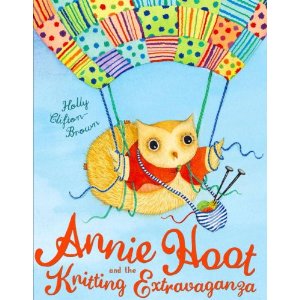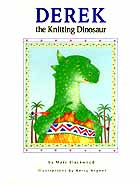What knitter hasn’t had the sad experience of working for hours on a gift item, only to discover that the recipient doesn’t like it, never wears it, or hid or gave it away? I like to call it UGGS: Unappreciated Gift Giver Syndrome, and I still avoid it by mostly knitting just for me. But UGGS also rears its ugly head in fiction, so here are three picture books about knitters looking for a little appreciation. As an added bonus, they all happen to be animals.

Annie Hoot and the Knitting Extravaganza by Holly Clifton-Brown.
Published in the UK and Australia before hitting the States, this book stars a sweet if slightly dim owl who loves to knit. Unfortunately, her strigine friends refuse to wear the brightly colored clothes she creates. So, she travels around the world (in various partially-knitted forms of transport) in search of some happy knitwear recipients. She tries the rain forest, the African plains, and the Arctic before getting a bit homesick (and running out of yarn). When she gets back home, she discovers that the other owls have come to appreciate her and her gifts. The storytelling is a little clunky, but the watercolor illustrations are adorable, even if it does look like Annie is knitting with two very large iron nails in a rather peculiar style. (It’s probably very hard to knit with wings.) I take issue with the depiction of penguins frolicking with polar bears up in the Arctic – it’s a pet peeve of mine – but they’re so darn cute!

Derek the Knitting Dinosaur, by Mary Blackwood, illustrated by Kerry Argent
In this rhymed-text import from Australia, Derek is a little green dinosaur with a problem. His brothers, Fang and Fearless, are big, fierce, scary dinosaurs who roar and stomp and fight while Derek just likes to sit inside, knitting and chatting with his friend Montmorency (a cute but quite toothy spotted mouse). Fang and Fearless aren’t all that bothered by Derek’s homebody ways, but he seems to worry that he should be more like them. When the weather suddenly turns colder, Derek’s brothers come to him for the one thing they can’t scare up: some warm clothes. The book closes with Fang and Montmorency agreeing what a good thing it is that “dear little Derek / would rather just sit, / and go / knittety / knittety / knittety / knit!” And Derek himself seems to be pleased enough to have finally found his place. Blackwood conveys an important message about appreciation of differences without being didactic, and Argent’s illustrations are charming. They also add some additional humor; there’s just something about the knitted underpants that makes me giggle.

Knitty Kitty, by David Elliott, illustrated by Christopher Denise.
“Clickety-click. / Tickety-tick.” A grandmotherly cat, complete with half-glasses perched on her nose and a cozy red shawl, sits in an armchair by the fire, knitting up a hat, a scarf, and mittens for three little kittens to wear while playing outside. They’re warm and cozy during the day, but having dressed their snowman in the knitwear, they find themselves chilly and uncomfortable in their sleeping basket at bedtime. Knitty Kitty, of course, has a solution; she curls up along with them in the basket. Denise’s acrylic and ink-on-paper illustrations depict a quaint little country cottage. While Knitty Kitty herself is very human-like, the kittens definitely act like kittens. They pounce on tails, wrestle with the mittens, and poke curiously at a stray ball of yarn. It’s easy to feel the energy of the three little kittens contrasted with the cozy room. A lovely twist on the Three Little Kittens nursery rhyme, this would be a good choice for a bedtime story.
 Bink and Gollie by Kate DiCamillo
Bink and Gollie by Kate DiCamillo









